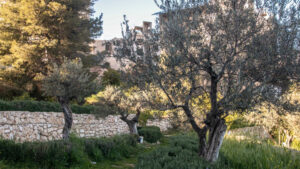Bethlehem Natural History Museum: A snapshot of Palestine before Israeli colonial terraforming

Olive trees in the garden of the Museum of Natural History, Bethlehem, occupied West Bank
Philippe Pernot writes in The New Arab on 12 July 2024:
The fight for the land is also a struggle to uphold an identity and way of life in Palestine. The link between society and the environment is strong, with the olive tree symbolising Palestinian resilience and rootedness.
This is why Bethlehem’s Museum for Natural History showcases endangered species, Palestinian culture, and ethnography.
Mazin Qumsiyeh started the project in 2014, and the museum opened to the public in 2017. “We’re celebrating our 10th anniversary, but this is a lifelong process,” the director tells The New Arab proudly.
Located on a hill close to the Separation Wall running through the town, the museum offers a space of relief and preservation: a community garden, a botanic garden, fishponds, a farm with chickens, rabbits, and doves, as well as two greenhouses using hydroponics and aquaponics. An animal rehabilitation unit even hosted two hyenas, a rare sight.
The New Arab was welcomed by Jessie Qumsiyeh, Mazin’s wife and co-founder, and taken for a tour through the gardens while the evening sun started its descent, projecting golden rays of light through the olive trees, gardenias, and herb bushes. Inside, the museum brims with fossils, stuffed animals, and information panels about Palestine’s environment and heritage. At first glance, the visitor may feel overwhelmed before delving into a treasure chest of information.
